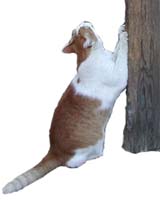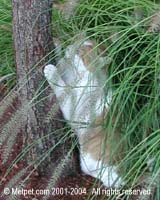Scratching Posts for Cats: Overview
Introduction to Cat Scratching Posts
MetPet.com Staff Writer
A scratching post is a stationary, usually vertical object that cats
use to maintain their front claws, stretch their muscles, leave
messages for other cats or shred for amusement. The most
basic scratching post is a tree with rough bark in a highly
visible and highly trafficked area.
scratching post is a stationary, usually vertical object that cats
use to maintain their front claws, stretch their muscles, leave
messages for other cats or shred for amusement. The most
basic scratching post is a tree with rough bark in a highly
visible and highly trafficked area.
Claw maintenance
Cats do not sharpen their claws but, instead, remove the dead
outer shell of their claws to expose fresh new claws. Like
snakes who crawl between rough rocks to help remove their outer
skin, cats dig their front claws into a scratching post to help
pull off the outer husk. They dig their hook like front claws into
the soft but firm surface and then pull their paws back and
down leaving the outer husk embedded in the surface or loose
enough to fall to the ground.
A well used scratching post usually has an outer
shell of a claw or two stuck in it or deposited around its base.
Since claws are often translucent and quite small, it takes some
careful searching to find one.
Cats maintain their back claws by chewing at the
outer shell instead of trying to drag their back paws down a
scratching post which would probably be more trouble than it's
worth. They will also, from time to time, chew on their
front claws to remove them as well.
Marking
for sight and scent
Even though cats are usually solitary creatures, they still need
to communicate with other cats even when they're not up close and
personal. Scratching posts are like bulletin boards with
various messages like 'no-trespassing' or 'kilroy was here' for
cats who have no access to pen and ink.
The deep scratches and shredded material of well used scratching
posts serve to show that another cat traveled this way or lives
here and is marking out its territory. The height of the
scratching probably shows just how tall a cat is which could serve
as a warning to smaller felines.
In addition to the visible marks in a scratching post, cats also
leave scent messages. Cats have glands on the pads of their
feet which deposit scent as they scratch.
Aside from identifying the various characteristics of each
specific cat, the scent deposits also indicate how recently each
cat was there which is important when cat territories overlap.
It is also possible that the personal scent serves to reassure the
cat itself. It is a way to identify
the boundaries of its 'property' or to remind the cat that it has
passed this way before and is not far from home.

Stretching after sleep
Cats are serious about slowly waking up from their frequent naps.
They stretch slowly and deliberately in their bed and then look
around for a good place to sink their front claws into. A
sturdy scratching post located right next to their favorite
sleeping spot provides traction and lets them get in a really good
deep stretch.
In this case, a solid tree situated right next to a grass bower
napping spot is very handy.
Amusement and attention
Some cats probably scratch and shred out of sheer boredom.
Indoor cats in particular might take out their anxiety and
frustration on the furniture or stereo speakers. In an
environment that never changes, shredding a new piece of furniture
every day may actually seem like a good idea.
Some cats have figured out that scratching at your prized
furniture will get a response from people. If attention is
what these cats crave, even if it's negative attention like
yelling, scratching can become a destructive habit.
Genetically inclined
It is thought that serious, continuous scratching (or shredding)
runs in families and may have a genetic component. It's also
possible that a mother cat teaches her kittens various skills and
habits thus passing on the impulse.
Cats without front claws
Even cats who have had their front claws removed or covered with
vinyl caps go through the motions of using a scratching post.
Even though they are doing nothing for their front claws, they are
still depositing their scent and engaging in an ingrained feline
habit.
Related information:
Scratching posts for cats: Structure
|
